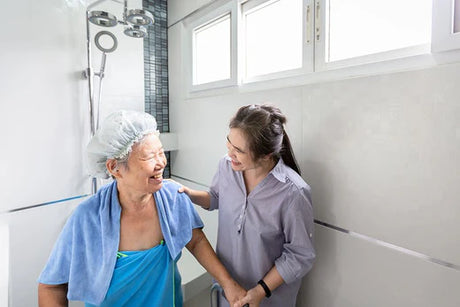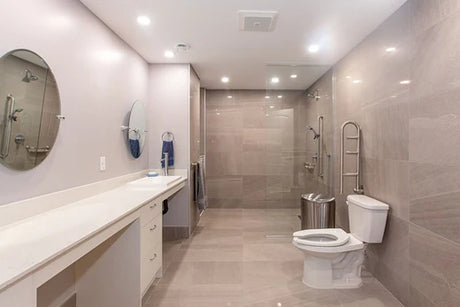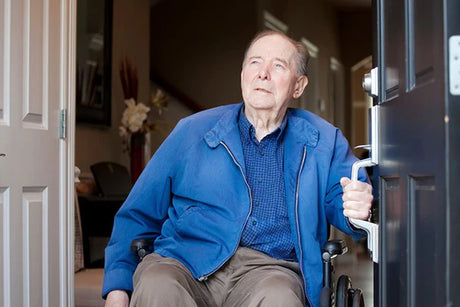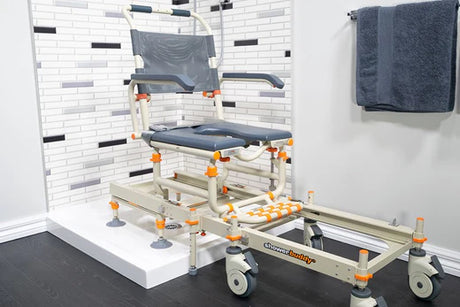Here’s 10 items that you may want to consider – check with your local health provider and/or occupational therapist, as some of these may be funded.
1 – Hoists
Hoists come in a variety of designs and functions. Essentially these are supporting harnesses that can lift and move the individual from one position to another. A hoist comes in a number of configurations including a free standing, non-fixed unit and as a ceiling mounted-permanent fixture. Usually the hoist will consist of a bar, mast, boom and other frame components. Most modern hoists are operated with buttons to adjust the position of the hoist. The user sits in a ‘sling’ which will be personal to them and their size.
Hoists don’t just help transferring between positions, but are also used in rehabilitation such as walking training, or simply to allow the user to assume a standing position. Exactly what a hoist will be used for depends greatly upon the user.
Because there are so many options for hoists, it’s important you speak with an Occupational Therapist about your needs before any decisions are made. They’ll ensure your solution is tailored to your needs, and not anyone else’s.
2 – Access Ramps
Stairs and edges present big barriers for someone with a mobility impairment. Ramps are often the most practical and cost effective solution for getting around these obstacles, with a huge range of options for both outside and inside the home.
If you’re a homeowner, it might be better to have permanent ramps installed such as wooden or concrete inclines. There are many removable options too, built from sturdy materials. These give a user the option to move them around and come with them should they move to a new house.
It’s really important to consider safety when getting access ramps installed. If there’s part of the home that can get cold and slippery, you’ll need to ensure adequate grip is incorporated into the surface.
3 – Railing
Rails around the home help individuals with paraplegia maneuver around with less difficulty. These are fixed to the wall and positioned at a height easily reachable to someone in a wheelchair.
Rails can be placed both outside the home (such as at the sides of an access ramp), or most rooms inside. Railing or ‘grab bars’ are very popular in bathrooms, but also commonly found in bedrooms, hallways and kitchens.
One potential challenge to getting rails or bars in the home is if the individual is renting a property. In these cases a conversation with the landlord would be needed to get the go-ahead.
4 – Accessibility Features On Devices
If mobility impairment is hindering the ability to interact with a device such as a computer, tablet or mobile phone, users can make sure of the sophisticated accessibility features offered. For example, the iPhone from Apple offers voice controls to help the user dictate messages, access menus and search information. The voice assistant on both iOS and Android can help conduct a lot of digital activity totally hands free. And with modern devices, many offer the unlock function via facial recognition.
- Read more about Apple’s accessibility features here.
- Read more about Android’s accessibility features here.
- Read more about Microsoft’s accessibility features here.
5 – Robot Vacuum Cleaners
A robot vacuum cleaner might sound like a luxury, but for those with an inability to do the vacuuming themselves, this technology is incredibly valuable. A robot vacuum cleaner will scan the floor and clean carpet, tiles and hardwood just like any other vacuum cleaner. After it’s done, it will go back and dock into the wall charger – once the science fiction appeal passes, owners are left with a useful assistive technology that keeps the floors clean.

6 – Smart Home Assistants
Along with personal devices, home assistants like the Google Home, Amazon Alexa and Apple’s Homepod Mini are all useful hands and screen free tools to get information and control things in the home like lights, heating and security. They’re also great for accessing the day’s news, weather and entertainment. How integrated these assistants are into your house depends on the other smart home fixtures your home has. Otherwise, they can act as useful standalone devices.
7 – Stair Lifts
This technology is more sophisticated than some of the other items on this list, but a stair lift is often the most important addition to a two-storey home or house located away from the road. Stair lifts are fixed to the side of a stairwell or flight of steps and provide a seat to sit on or alternatively a platform on which a wheelchair can be carried up and down.
These lifts aren’t inexpensive but may be at least partially funded depending on your needs and location. As with any permanent fixtures, you will have some restrictions around what can be done with a rental property.
8 – Wheelchairs
A wheelchair is one of the more central technologies to most mobility impaired individuals. Wheelchairs come in a huge number of formats from self-propelled to motorised, reclining to all-terrain. Wheelchairs will be configured based on the requirements of the user such as additional neck support.
Wheelchairs can also be fitted with other technology such as digital devices.

Read more about choosing a wheelchair in Christopher Reeve Foundation’s article here.
9 – Mobility-friendly beds
Getting in and out of bed can present challenges for someone with mobility impairment. Purpose-design beds are available that offer height adjustment, inclining backrest, side rails and steps. Together with a carer and capable chair, transferring in and out of bed can be made much easier.
10 – Bathroom transfer
One of the most complex daily tasks is using the bathroom. Using the toilet and bath or shower requires various movements and stability to execute safely. This can be complicated even further in a moisture-filled environment. Instead of risking injury to both user and carer, we’d suggest looking into a quality bathroom transfer system. Instead of moving out of a wheelchair and into a shower chair or toilet support, users can stay in one chair before entering the bathroom, and be transferred over the toilet and into the shower, regardless of the format (bathtub, roll-in, shower unit etc).

Learn more about bathroom transfer solutions
Showerbuddy provides a range of transfer systems that fit most bathrooms around the world. Our system allows comfortable, sturdy movement around the bathroom to conduct your daily routine. Thanks to the smart design, users are afforded more independence and dignity in the bathroom. You can learn more about Showerbuddy or, get in touch with our team to arrange a demo with your nearest distributor.
Further Reading
- What are some types of assistive devices and how are they used? – nichd.nih.gov
- Assistive technology – Wikipedia
- Best Assistive Technologies 2021 – Laptop Mag














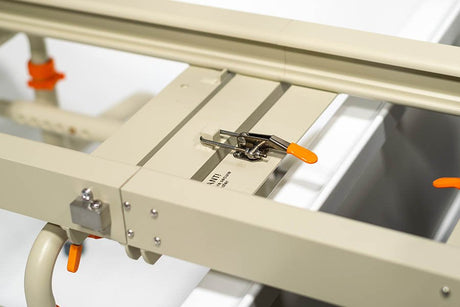











![Toilet Training A Young Child With Mobility Challenges [And How A Shower Chair Can Help]](http://shower-buddy.com/cdn/shop/articles/toilet-training-disabled-child_520x500_a90e5234-d372-435d-aa56-8da15dd3836c.webp?v=1722557239&width=460)







